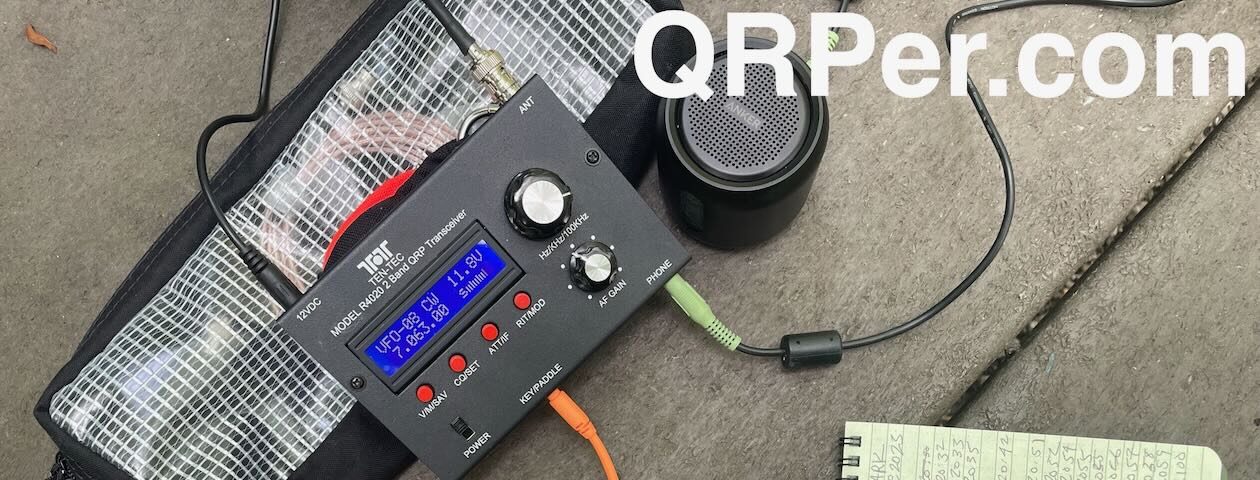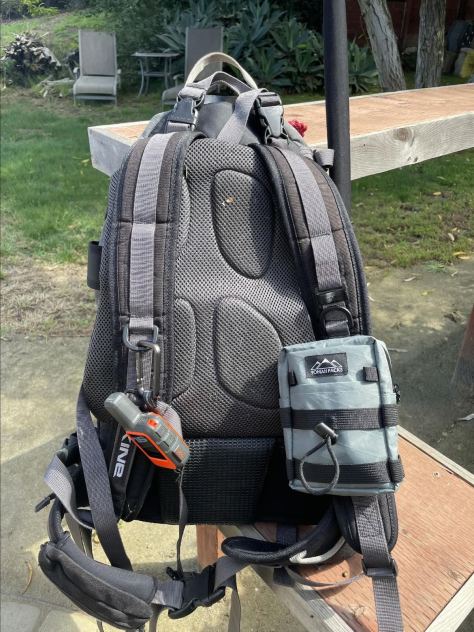Many thanks to William (KR8L) who shares the following article about his portable field radio kit which will be featured on our Field Kit Gallery page.
If you would like to share your field kit with the QRPer community, read this post. Check out William’s field kit below:
KR8L POTA Field Kit Components
 KX2 Bag (CS40)
KX2 Bag (CS40)
- KX2 with internal battery and ATU (this link applies to the KX2 and all Elecraft KX2 accessories)
- KX2 microphone
- “S” hook for hanging the microphone from my little finger (for /PM)
- CWMorse Pocket Paddles
- Velcro (double sided) for belt and leg straps
- CWMorse QRP Nano straight key
- Earbuds
- “Random” wire antenna (about 36 feet long) with banana plug
- Counterpoise with banana plug, with 2 mm banana plug/jack disconnects to make it a quarter wavelength for 40, 30, 20, 17, 15, 12, or 10 meters
- Small bungee cord
- Gear ties (2)
- KX2 power cord
- BNC to binding post adapter
- 3.5 mm TRS cable for paddles and key
- Micro paracord, 20 feet
- Pen
- Paper
Battery Bag with shoulder strap (unknown origin)
L.L.Bean ACS Day Pack with the following:
Maxpedition Beefy Pocket Organizer
- AXE1 40 meter loading coil
- AX1 telescoping whip
- RG316, six feet, with BNCs
- Manfrotto Pixi mini tripod
- AXT1 tripod adapter
- AXB1 bipod
- BNC right angle adapter
- Counterpoise, Elecraft short, for AX1, AX2 (2)
- Counterpoise, Elecraft long, for AXE1
- Counterpoise, homebrew with 2.5 mm banana plug, 13 feet
- Small gear ties (2)
Maxpedition Gear Cocoon Pouch
- AX1 loading coil
- AX1 telescoping whip
- AX2 loading coil
- Counterpoise, homebrew with 2.5 mm banana plug, 13 feet
Stuff Sack #1
- Notch Acculine 1.75mm Throwline, Dyneema, 180 feet (two pieces, 120 and 60 feet)
- Notch 8 ounce throw weight
Stuff Sack #2
- RG174, 25 feet, with BNCs
- RG316, three feet, with BNCs
Stuff Sack #3
- QRPGuys Mini 49:1 transformer
- Tent stakes, small (3)
- Gear Ties (2)
- Micro paracord, 25 feet
- Paracord, three feet (3)
- Small bungee cords (4)
- 40 meter EFHW wire
- 20/10 meter EFHW wire with the following adapters:
- 40 meter loading coil and extension (34 microhenry coil and an additional 68 inches of wire)
- 17 meter adapter*
- 15 meter adapter*
- 12 meter adapter*
Loose Items in L.L.Bean pack
- Small clipboard (9×6 inch) with paper
- Pen
- Small plastic tarp
- CB Telescoping Whip with BNC (for 10 meters)
- Sony ICD-UX570 Digital Voice Recorder
- AGPTEK Carrying Case for Sony recorder
Note: The 20 meter EFHW wire has a connector in the middle of the length. By unplugging this connector and removing the half of the wire at the “far” end (i.e., away from the transformer and feedpoint) and replacing it with one of these adapters, the wire is then reconfigured to be an EFHW for 17, 15, or 12 meters.
Other Items as Appropriate (most items not for hikes of any great distance)
- Camera tripod
- Spiderbeam mast, 7 meters
- Spiderbeam mast, 12 meters
- B’n’M Black Widow fishing pole, 20 feet
- Stuff sack #4 with rope, tent stakes, mallet, etc. for guying masts
- Bicycle rack on truck (for mast support) [No longer made but similar to this product. ]
- BLUU Small Backpacking Chair (the case has been fitted with a rope sling so it can be carried moderate distances) [no longer available]
Summary
My experience from years of traveling for both pleasure and business has shown that I always overpack and take too much “stuff”, and POTA is no exception. However, I have made an attempt to modularize my POTA gear so that I can lighten my load depending on what type of activation I have planned and how far I will be going from my parking spot. If you will spend some time scrolling through my blog, you’ll find examples of most of the following:
If I’m going to a location where I’m planning on operating at or not too far from my truck, I’ll take everything on this list to give me maximum flexibility as to how I set up. Probably the most extreme setup involves erecting my 12 meter Spiderbeam mast on my heavy duty towing-style bicycle rack and deploying a wire antenna as an end-fed vertical or as a sloper.
At the opposite end of the spectrum, if I’m going to be doing a pedestrian mobile (/PM) activation then all I need is my KX2 bag, my Maxpedition Gear Cocoon Pouch, probably my Sony ICD-UX570 Digital Voice Recorder (unless I can manage to log on paper somehow), and (optional) my battery bag with shoulder strap.
If I know that I’ll be doing a wire antenna activation using a tree for support then I can wear my L.L.Bean day pack, but omit the Maxpedition Beefy Pocket Organizer and the Maxpedition Gear Cocoon Pouch. In that case I’ll likely wear my battery bag with shoulder strap. I may put the KX2 bag in the pack or carry it by its handle.
And, if I know that I’m going to be doing an AX1/AXE1/AX2 picnic table activation then I can omit Stuff sacks #1,# 2, and #3, but otherwise wear my day pack and battery bag as described above.
Of course, there are always variations, such as using the camera tripod, AXT1, and RG174 coax to set up at a picnic table, but allow the AX1/AXE1/AX2 antenna to be more in the clear (such as operating from a picnic shelter).
I’ve also done what you might call “pedestrian stationary”, deploying the KX2 HT-style and hand-held, but sitting in my backpacking chair. Or deploying a wire antenna (EFHW or “random”), but sitting in the backpacking chair with the rig balanced on my leg. By traveling with “everything” but packing in a modular fashion, there are any number of variations on how I can set up for an activation.


















































